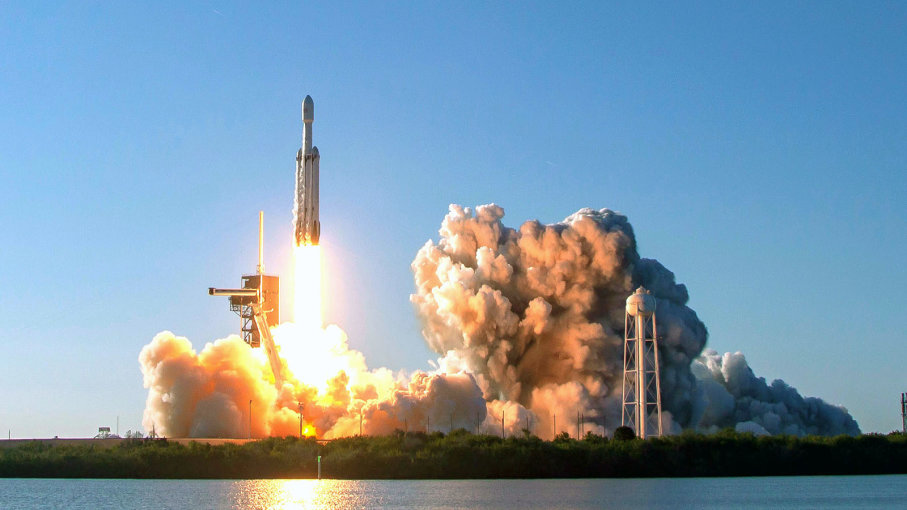NASA Sets Launch Times With Science and Precision

On April 11, 2019, a SpaceX Falcon Heavy rocket launched from Launch Complex 39A at NASA’s Kennedy Space Center in Florida. SPACEX
It’s hard to believe that almost half a century’s gone by since Neil Armstrong, Edwin “Buzz” Aldrin and Michael Collins blasted out of the Kennedy Space Center in Cape Canaveral, Florida with a presidential promise to fulfill. But here we are.
The Apollo 11 mission launched on July 16, 1969 at 9:32 a.m. (Eastern Standard Time). NASA didn’t pick that start time at random. It was chosen because it checked off the right boxes on a long list of requirements. You see, crafting launch schedules has always been a rigorous science.
Land Like an Eagle
Every mission has its goals. In Apollo 11’s case, the main objective was to put an American astronaut on the moon, winning the space race for old Uncle Sam. To that end, NASA selected five potential landing sites just above the lunar equator. Since nobody likes a bumpy landing zone, the candidate sites were geographically flat.
But the spacemen couldn’t just head out at their earliest convenience. A lunar day lasts for 29.5 Earth days. So if you were to stand at a given point on the moon’s surface for that amount of time, you’d experience about 14 straight days of nonstop sunlight — followed by roughly 14 uninterrupted days of darkness. For Apollo 11, NASA went full Goldilocks. The agency decided that the crew’s now-famous “Eagle” module needed to land at lunar dawn, when the sun is low but still visible.
Shadows became a topic of discussion. If the ground-level shadows were too long or too short when Armstrong and company first arrived, they’d cause visibility problems. Therefore, the Eagle would have to touch down while the sun was between 15 and 45 degrees above the lunar horizon.
Travel Plans
These factors helped give NASA a set of launch windows. Basically, a launch window is the time frame in which a spacecraft can leave the Earth. They’re often quite narrow — especially when complex maneuvering is involved.
Let’s revisit Apollo 11. The crew had to blast off; position themselves over a specific corner of the Earth; shoot toward the moon; and then land the Eagle at a pre-approved site during lunar dawn while the sun was 15 to 45 degrees overhead. Talk about a strict itinerary.
Of the five possible landing areas, NASA ultimately chose the Sea of Tranquility. They wanted to put Armstrong and Aldrin up there late in the summer of ’69. The lunar orbit meant that NASA would only get two chances to hit a moving target. In order to reach the Sea of Tranquility under the perfect set of conditions, Apollo 11 had to take off on either July 16 or August 14.
NASA picked the former date. The July 16 launch window was open from 9:32 a.m. to 1:54 p.m. To buy the crew some extra time in case they needed it later, Apollo 11 was sent skyward at the earliest possible opportunity — which is to say, right when the window opened.
Four days later, Armstrong and Aldrin were doing the moonwalk. The astronauts returned to Earth on July 24.
NASA_Langley
✔
@NASA_Langley
NASA’s Space Launch System will be the most powerful rocket we’ve ever built. When completed, @NASA_SLS will enable astronauts to explore destinations far into the solar system, including the Moon. Learn how SLS is getting ready for #Moon2024: https://youtu.be/a9VCnKkDuXI
YouTube at 🏠 @YouTube
120
7:04 PM – May 20, 2019
Twitter Ads info and privacy
44 people are talking about this
Threading the Needle
Fifty years later, launch schedules are still notoriously hard to plan. As NASA’s official website dryly notes, “This is not a job for someone who slept through physics class.”
Launch windows are inevitably shaped by mission objectives. Want to send a rover up to Mars? Your best bet might be to wait until Mars and Earth find themselves in “opposition” — a point when the gap between the two planets is fairly short and they’re both on the same side of the sun. That opportunity only comes along every 26 months.
If a spacecraft is supposed to visit another heavenly body (like Mars or the moon), its travel plans will be dictated by the other world’s orbital pathway and Earth’s own trajectory. And that’s not all; the gravitational influence of other bodies — such as the sun — must also be considered.
Plus, manmade devices always encounter friction and wind when they pass through Earth’s atmosphere. That interference is guaranteed to affect launch trajectories — and by extension, launch windows.
Space Labs and Stormy Skies
So atmospheric pushback isn’t just a problem for deep-space missions. Even crafts that were built to orbit the Earth and go no further have to deal with this issue.
One such object is the International Space Station (ISS). A crewed laboratory, the ISS orbits roughly 220 miles (350 kilometers) above Earth, completing about 16 revolutions around the planet every day.
NASA used to send astronauts up to the ISS in reusable Space Shuttles. Every day, the ISS would pass over (or near) the launching site at Cape Canaveral. For a successful rendezvous to occur, NASA’s shuttles needed to take off within five minutes of that passage. And to avoid dumping fuel tanks onto populated areas, the ships had to follow a south-to-north trajectory over the Atlantic Ocean.
You won’t see any of those launches on NASA’s 2019 schedule. The American space shuttle program was retired in 2011 and NASA no longer ferries astronauts to the ISS. (At the moment, that’s Russia’s job.)
Regardless, the Kennedy Space Center sees off loads of other missions every year. By the way, NASA’s got plenty of other launch sites at its disposal, including the Vandenberg Air Force Base in southern California.
Wherever a launch is scheduled to begin, you can bet that NASA meteorologists are paying close attention to the weather. Early in 2019, the much-anticipated liftoff of a SpaceX Falcon Heavy Rocket at Cape Canaveral was delayed due to high winds. Back in 1971, “weather constraints” forced NASA to postpone the Apollo 14 launch by 40 minutes.
Rain, lightning and wind aren’t the only things that could potentially interfere with a launch. To avoid putting any passing airplanes in harm’s way, NASA collaborates with the U.S. Air Force and Federal Aviation Administration to close large swaths of commercial airspace during launch windows.



 Creators of mankind
Creators of mankind Description of “Tall white aliens”
Description of “Tall white aliens” Where they came from?
Where they came from? About hostile civilizations
About hostile civilizations The war for the Earth
The war for the Earth “Tall white aliens” about eternal life
“Tall white aliens” about eternal life Video: “Nordic aliens”
Video: “Nordic aliens” Aliens
Aliens Alien encounters
Alien encounters The aliens base
The aliens base UFO
UFO Technology UFO
Technology UFO Underground civilization
Underground civilization Ancient alien artifacts
Ancient alien artifacts Military and UFO
Military and UFO Mysteries and hypotheses
Mysteries and hypotheses Scientific facts
Scientific facts


















